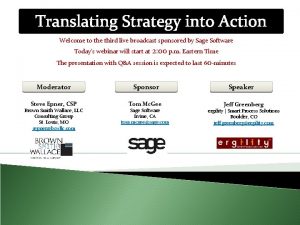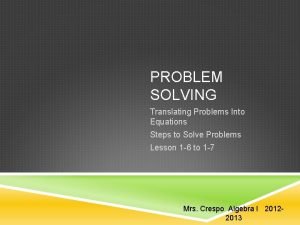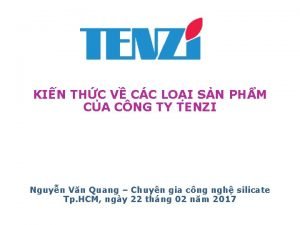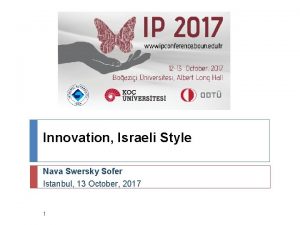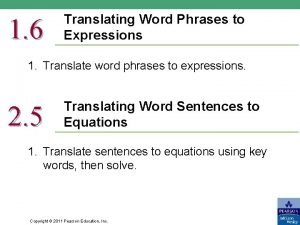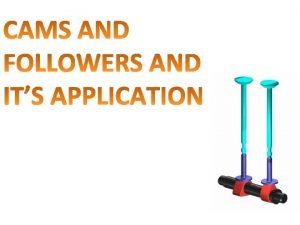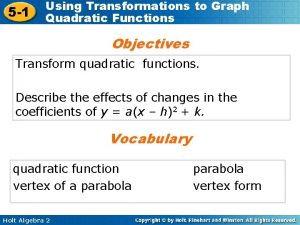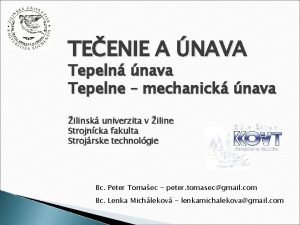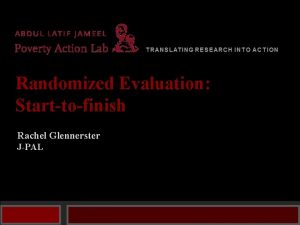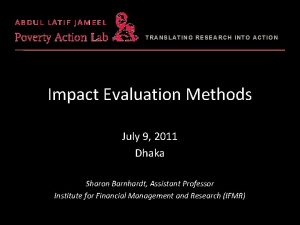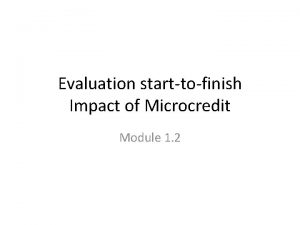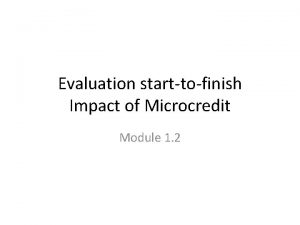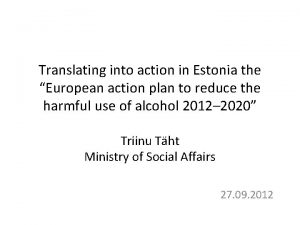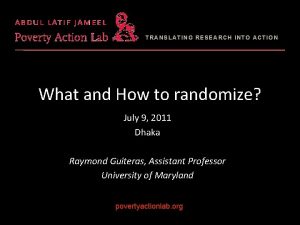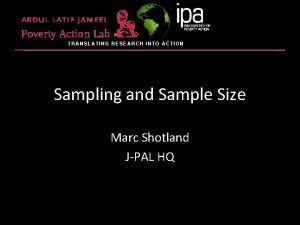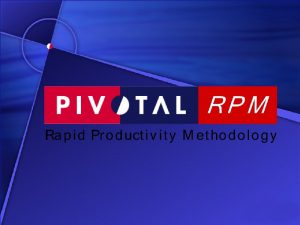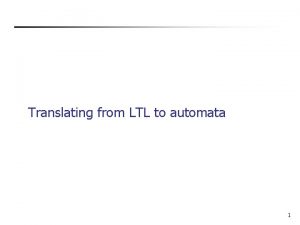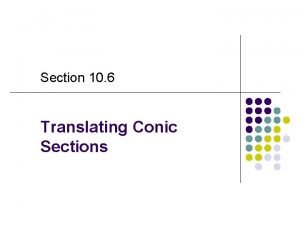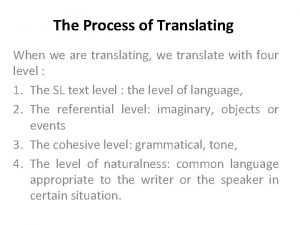TRANSLATING RESEARCH INTO ACTION Randomized Evaluation Starttofinish Nava







































- Slides: 39

TRANSLATING RESEARCH INTO ACTION Randomized Evaluation Start-to-finish Nava Ashraf Abdul Latif Jameel Poverty Action Lab povertyactionlab. org

Course Overview 1. 2. 3. 4. 5. 6. 7. 8. Why evaluate? What is evaluation? Outcomes, indicators and measuring impact Impact evaluation – why randomize How to randomize Sampling and sample size Implementing an evaluation Analysis and inference Randomized Evaluation: Start-to-finish

The setting: Green Bank of Caraga

The setting • Philippines • Green Bank • Microsavings and “MABS” MABS Training for lenders

The need • • Savings is low People rely on debt People want to save Focus groups The Economic Lives of the Poor (Banerjee, Duflo (2006))

Motivations • Theoretical Motivation: – “Standard economic man” versus “Behavioral Economics man” (Exponential discounting models versus hyperbolic/temptation models) • Policy Motivation: – Small changes & big effects: Applying lessons from psychology to economics & public policy or business practices – Hard evidence on need for specialized savings products. Access alone does not help everyone. – Microfinance research (& policy) focuses heavily on microcredit, not microsavings. Much remains to be learned about how to help poor people save more.

Program theory • “Time inconsistency” – Irrational behavior? – Subject to temptation? • Intra-household decision making • Commitment • Anecdotal evidence


SEED: A Commitment Savings Product • Commitment savings products create withdrawal restrictions to incentivize longterm savings • SEED is a product of the Green Bank, a rural bank in the Philippines with the following characteristics: – Withdrawal restriction – Deposit incentive – Same interest rate as regular savings account

“…but you must bind me hard and fast, so that I cannot stir from the spot where you will stand me… and if I beg you to release me, you must tighten and add to my bonds. ” --- The Odyssey


Why Evaluate? • The bank enjoyed a reputation for product innovation • “Look at our growth, it’s obvious we’re better than our competition” • “If we think this is what the market wants, then let us introduce it and find out right away” • “But this time, before we jump into the water, we need to take the temperature. ”

Goals and Measurement • Private mission • Social mission • Metrics – Institutional data – Crowd out • Product or just encouragement to save?

Encouragement…

Planning and Design • Identify problem and proposed solution – Define the problem both through qualitative work and your own academic background research – Define the intervention – Learn key “hurdles” in design of operations • Identify key players – Top management – Field staff – Donors

Planning and Design • Identify key operations questions to include in study – Find win-win opportunities for operations – How to best market? – How to sustain the program? • Pricing policy • Generating demand through spillovers – Types or extent of training?

Process • Extensive piloting

Pilot • • Pilots vary in size & rigor Pilots & qualitative steps are important. Sometimes a “pilot” is the evaluation Other times they are pilots for the evaluation

Why randomize • Take-up and selection bias

Planning and Design • Design randomization strategy – Basic strategy – Sample frame – Unit of randomization – Stratification • Define data collection plan

Study design: basic strategy Barangay/Village Stratified by: Average Savings Levels & Percentage of Population with Accounts Randomly assigned to: Control Group Treatment Group 1 Regular Savings Product (Simple Encouragement to Save) Treatment Group 2 Commitment Savings Product

Study design: randomization unit • • • Individual? Barangay? Spillovers Green bank’s reputation Sample size?

Discussion of sample size • Dean Karlan: – “Intra-cluster correlation will be small” • Nava Ashraf: – “What? No! There are lots of Barangay-specific shocks! Intra-cluster correlation will be large!” • Dean Karlan: – “There’s no way the Bank will let us randomize at the individual level!!” • Nava Ashraf: – “Let’s see!”

Study design: sample frame • • Sample frame: 4, 000 existing (or former) bank clients 3, 154 individuals randomly chosen to be surveyed 1, 777 surveys completed Participants randomized individually into: – Treatment (Offered SEED), 50% – Marketing(Encouraged to Save), 25% – Control (Nothing), 25% • • Marketing team from Bank visited one-on-one with T & M groups 28% of Treatment group took-up Marketing & Control groups not allowed to take-up Six months and then 12 months later we collected bank savings data on all 3 groups – Data from SEED account – Data from their normal savings account • Follow up Survey 2 years after

Baseline Survey: Two Purposes • Understand take-up decision • Pre-intervention measurements in order to measure changes in savings/income and assess welfare implication from intervention

Implementation 1. Identify “target” individuals and collect baseline data 2. Randomize – Real-time randomization – All-at-once randomization – Waves 3. Implement intervention to treatment group – Ensure internal control 4. Measure impact after necessary delay to allow impact to occur – Common question: “How long should we wait? ” – Operational considerations must be traded off. No one-size -fits-all answer. – Want to wait long enough to make sure the impacts materialize.

Dealing with fairness Dear Valued Client Mr. /Mrs. ________ We at Green Bank are committed to offering the best products we can to our clients. We are very happy that you have shown interest in our new product, SEED. However, we are still piloting the SEED savings product, and are not offering it yet to all of our clients. We are doing a slow-rollout of the SEED product, to only an initial 1000 clients for this year. During this year, we will monitor the product and its impact, and then perfect it before offering it to all of our clients.

Dealing with fairness Please do not be sad that you were not chosen as part of the initial 1000 clients. These clients were chosen randomly, through a lottery/raffle draw. We put all of our valued clients’ names into a box, and then randomly selected 1000 clients to be the first to get the SEED product during the pilot phase. We did this randomly so that we could be as fair as possible to all of our clients.

Dealing with fairness We at Green Bank care very much about each and every one of our clients. We also care about being fair to all clients, and about creating and perfecting the best savings services and products to help our clients improve their lives. Doing a slow-rollout of this new SEED savings product to a randomly chosen group of clients is the best way to do this. We sincerely hope you understand, and look forward to offering you the new and improved SEED in July, 2004.

Preview of the Warts! • Sample frame: Existing & prior clients of a bank – Hence, not an intervention on the “general” public – Perhaps not bad, because it means the impact does not come merely from expanding access • Take-up predicted by hyperbolicity only for women – Women more “sophisticated”? – Externalities to family internalized by women, not men? • No data on substitution from non-bank savings – But we do observe change in non-SEED savings at the bank

Measuring Impact • Intent to Treat: Compare means between groups • Treatment on the Treated: Instrumental variable approach, effectively scaling-up impact by proportion who took up – Assumption #1: Take-up correlated with instrument. – Assumption #2: “Exclusion restriction”

Preview of Good Results • Impact: – Average bank account savings increase for those assigned to treatment (ITT): after 6 months=46%; after 12 months=80% increase – Scaling up estimate by those who actually opened the account: increase in average savings (TOT): after 6 months =192%; after 12 months= 337% increase – 28% of those offered the product took-up • Takeup: – Women with hyperbolic preferences are more likely to open the Commitment Savings Account (SEED) than women without hyperbolic preferences (not true for men)

Measuring Impact

Measuring Impact

Magnitude in Real Dollars • Doctor’s visit: 150 pesos • Public school fees are 150 pesos/year, plus ~200 pesos/month for special projects • 1 month supply of rice for a family of 5: 1000 pesos

Sub-group Impacts • No differential impact for: – female – college – time inconsistent – household income

Conclusions • Commitment Savings Product design features correctly attracts individuals with hyperbolic preferences or who put self-control devices in place to overcome temptation problems • Impact – Treatment on the Treated: Average savings increased by over 300% – Intent to Treat: Average savings increases by 80% • ~34% of SEED clients actively using the account • Puzzle remains: why does “hyperbolic” predict take-up only for women?

Further Research (1) • Follow-up survey (2. 5 years later) told us: – No Substitution from other non-bank savings – Welfare implications • • Better able to handle shock? Less able to handle shocks? More likely to invest in long run items? Fewer Coke’s, Bigger Parties? – Still implies higher average savings for the bank – Additional Impacts: Women’s Decision Making Power significantly increased (Ashraf, Karlan & Yin (2007): “Female Empowerment”)

Further Research (2) • Further intervention tests will tell us: – Scalable? Expanding into new branches, full marketing launch – Further product tweaks – Deposit collectors (Ashraf, Karlan and Yin (2005) Advances in Economic Analysis and Policy)
 Translating strategy into action
Translating strategy into action Translating sentences into equations
Translating sentences into equations 1-4 translating words into symbols answer key
1-4 translating words into symbols answer key Translating word problems into equations
Translating word problems into equations Translating english into logical expressions
Translating english into logical expressions Translating research findings to clinical nursing practice
Translating research findings to clinical nursing practice Research action communication evaluation
Research action communication evaluation Nava raatri
Nava raatri Keo dán gạch kelas
Keo dán gạch kelas Nava swersky sofer
Nava swersky sofer Felice alfonso nava
Felice alfonso nava Santiago nava townsend
Santiago nava townsend Dulcineas de nava receta
Dulcineas de nava receta Dr jennifer beck
Dr jennifer beck Jorge nava pintor
Jorge nava pintor Cha vha slide
Cha vha slide Salvador aguilar cruz músico
Salvador aguilar cruz músico Brenda maritza guevara contreras
Brenda maritza guevara contreras Cetoacidosis diabetica
Cetoacidosis diabetica Graph using transformations
Graph using transformations Translating expressions and equations
Translating expressions and equations Translating inequalities
Translating inequalities Translating equations
Translating equations Two less than a number
Two less than a number Clamshell door thrust reverser
Clamshell door thrust reverser Verbal expression math
Verbal expression math Transformation graphs worksheet
Transformation graphs worksheet Transforming linear functions lesson 6-4
Transforming linear functions lesson 6-4 Relative motion of two particles using translating axes
Relative motion of two particles using translating axes Schleiermacher on the different methods of translating
Schleiermacher on the different methods of translating Translate x + 32 a verbal phrase
Translate x + 32 a verbal phrase Using transformations to graph quadratic functions
Using transformations to graph quadratic functions Thrust reverser
Thrust reverser Waterfall compound word
Waterfall compound word Exponential graphs transformations
Exponential graphs transformations Translation of financial statements
Translation of financial statements Translating between tables and expressions
Translating between tables and expressions Translating contracts
Translating contracts When a disc cam operates a translating roller follower
When a disc cam operates a translating roller follower Using transformations to graph quadratic functions
Using transformations to graph quadratic functions
